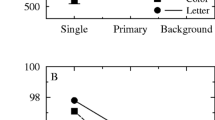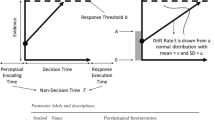Abstract
The phenomenon of recovery, a transient enhancement of performance following an interruption, is demonstrated to occur in controlled continuing association. The effect is shown to be manipulable by changing the experimental procedure. It appears to be a fairly common behavioral process, observable with a wide range of activities.
Similar content being viewed by others
References
BOUSFIELD, W.A. 1933. Certain quantitative aspects of the feeding behavior of cats. Journal of General Psychology, 8, 446–454.
BOUSFIELD, W.A., & SEDGEWICK, C.H. 1944. An analysis of sequences of restricted associative responses. Journal of General Psychology, 30, 149–165.
BOUSFIELD, W.A., SEDGEWICK, C.H., & COHEN, B.H. 1954. Certain temporal characteristics of the recall of verbal associates. American Journal of Psychology, 67, 111–118.
CRAMER, P. 1968. Word association. New York: Academic Press.
GRUENEWALD, P.J., & LOCKHEAD, G.R. 1980. The free recall of category examples. Journal of Experimental Psychology: Human Learning and Memory, 6, 225–240.
INDOW, T., & TOGANO, K. 1970. On retrieving sequence from long-term memory. Psychological Review, 77, 317–331.
JOHNSON, D.M., JOHNSON, R.L., & MARK, A.L. 1951. A mathematical analysis of verbal fluency. Journal of General Psychology, 44, 121–128.
LOCKARD, R.B. 1964. A method of analysis and classification of repetitive response systems. Psychological Review, 71, 141–147.
McCLEERY, R.H. 1977. On satiation curves. Animal Behavior, 25, 1005–1015.
MALONE, J.C. 1976. Local contrast and Pavlovian induction. Journal of the Experimental Analysis of Behavior, 26, 425–440.
POLLIO, H.R. 1964. Composition of associative clusters. Journal of Experimental Psychology, 67, 199–208.
POLLIO, H.R., KASSCHAU, R.A., & DE NISE, H.E. 1968. Associative structure and the temporal characteristics of free recall. Journal of Experimental Psychology, 76, 190–197.
POLLIO, H.R., RICHARDS, S., & LUCAS, R. 1969. Temporal properties of free recall. Journal of Verbal Learning and Verbal Behavior, 8, 529–536.
DE RIVERA, J. (Ed.). 1975. Field theory as human-science. New York: The Gardner Press.
SKINNER, B.F. 1932a. Drive and reflex strength. Journal of General Psychology, 6, 22–37.
SKINNER, B.F. 1932b. Drive and reflex strength Ii. Journal of General Psychology, 6, 38–48.
SKINNER, B.F. 1938. The behavior of organisms. New York: Appleton-Century.
VERPLANCK, W.S., COLLIER, G.H., & COTTON, J.W. 1952. Nonindependence of successive responses in measurements of the visual threshold. Journal of Experimental Psychology, 44, 273–282.
Author information
Authors and Affiliations
Rights and permissions
About this article
Cite this article
Molina, E.J. A Demonstration of Recovery in Controlled Continuing Association. Psychol Rec 32, 381–396 (1982). https://doi.org/10.1007/BF03394797
Published:
Issue Date:
DOI: https://doi.org/10.1007/BF03394797




